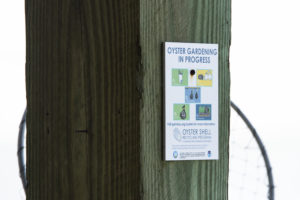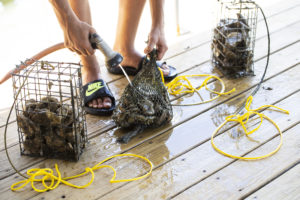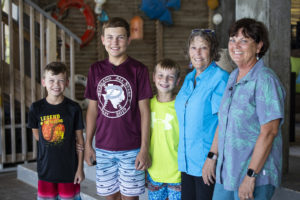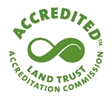Oyster Gardening a Growing Sensation on Tiki Island
- August 02, 2022
- News
There is a popular saying around the village of Tiki Island.
“Spat is where it’s at,” exclaimed Patty White, an island resident and a volunteer with Galveston Bay Foundation’s Oyster Gardening Program.
White, a retired math and science teacher, and her husband Don permanently relocated to Tiki Island six years ago. Shortly thereafter she was approached by her neighbor Maureen Wilde about participating in a new program – growing baby oysters from the dock at her home located on one of the island’s canals.
“I actually did it just to meet people,” White said. “We moved down here, and it sounded like fun. Let’s do it!”
Wilde and her husband Alan heard about the program in Bayou Vista and wanted to bring it to Tiki Island.
“We said, ‘If they do it over there, we can definitely do it here,’” she explained.
Four families, the Wildes, Whites, Longs and Wrights, started oyster gardening on Tiki Island five years ago. Now the program has blossomed to include approximately 45 island families.
The requirements for being a volunteer oyster gardener are about as straightforward as the process for tending to them. Volunteers simply need to have access to the Bay from a pier or dock. The Galveston Bay Foundation supplies them with wire cages, mesh bags, and/or stringers filled with cured recycled oyster shells collected from restaurants that are suspended at least a foot deep in the water.
Once a week, the volunteers pull their gardens ashore, rinse off any mud and debris, and shake out any “critters,” such as crabs and fish, that may have found their way inside the cages or bags. The oyster gardens are then left out in the sun for an hour to an hour and a half before being returned to the water to reduce algae growth.
The goal of the program is to attract spat on the recycled shell substrate from nearby spawning oysters and then to transplant them onto Galveston Bay Foundation’s restored reefs around the Bay.
 “You start with a blank slate then several weeks later, you’re growing stuff,” White said.
“You start with a blank slate then several weeks later, you’re growing stuff,” White said.
White’s grandchildren Chase, 13, and twins Kyle and Jake, 12, who live in Pearland, assist with cleaning the gardens when they visit their grandparents.
“It’s fun to clean them off and see how big or small the spat is,” Chase said.
And it’s not just White’s grandkids who get excited by what they find.
“At any age you can always learn something,” White said. “This for me, in retirement, has been like, ‘Wow, I didn’t even know you could do this.’”
Wilde expressed a similar sentiment.
“It’s one thing to talk about something, but you can see after four weeks we have this many oysters already,” Wilde said.
 After oyster gardening for five years, the volunteers on Tiki Island have observed some interesting trends. The Wildes, who live bayside, recruit more spat than the Whites do at their canal-side home. The recycled shells in wire cages tend to produce more oysters than those in the mesh bags. And years with a lot of rainfall have yielded fewer oysters because of the increased freshwater flowing into the Bay.
After oyster gardening for five years, the volunteers on Tiki Island have observed some interesting trends. The Wildes, who live bayside, recruit more spat than the Whites do at their canal-side home. The recycled shells in wire cages tend to produce more oysters than those in the mesh bags. And years with a lot of rainfall have yielded fewer oysters because of the increased freshwater flowing into the Bay.
Last year was highly productive for the gardeners. On one shell alone, Wilde counted 32 baby oysters.
“Each week it’s always an adventure because you never know what will come up,” she said.
Aside from the personal enjoyment volunteers get from their gardens, there is a greater purpose to their work.
“Look where we live. Our reefs are going away,” Wilde said. “…Oysters are an ecosystem, and they also stop erosion, and they play a major part in getting back a healthy Bay and healthy Gulf.
“That’s why we do it,” she explained. “I mean, I don’t even eat oysters!”
 Oyster gardening has also brought the residents in the village together. The Wildes often host “Tiki happy hours” while cleaning their gardens in addition to “spat interventions” to assist new program volunteers. They also started a Facebook group called the Tiki Island Spat Lovers to share updates on their oysters and other marine life found in their gardens.
Oyster gardening has also brought the residents in the village together. The Wildes often host “Tiki happy hours” while cleaning their gardens in addition to “spat interventions” to assist new program volunteers. They also started a Facebook group called the Tiki Island Spat Lovers to share updates on their oysters and other marine life found in their gardens.
“How many things can you do today that can get a community to get together and agree on one thing?” Wilde asked.
“An oyster,” White exclaimed.
Wilde laughed
“An oyster,” she echoed. “And really enjoy doing it. I think that’s great!”
If you are interested in becoming a volunteer oyster gardener, contact Shannon Batte at sbatte@galvbay.org or (832) 536-2265.





